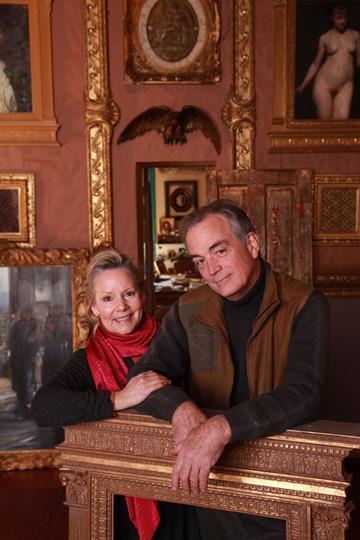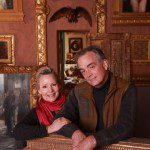A Golden Passion: The Art of Bill Adair
By • May 3, 2012 0 3835

Nestled like an egg in a courtyard of high-rises and apartment buildings just off Dupont Circle sits Gold Leaf Studios. A 10,000-square-foot carriage house built in 1903 by Evalyn Walsh McLean, the building stands as an urban anomaly — one of those small architectural wonders that momentarily suspends reality when first seen. Its stucco walls and adobe tile roof recall something of the Old West, as if at any moment a cowboy-capped young stablehand will swing open the heavy wooden door and wonder aloud what sort of business a confused looking man in strange, foreign clothes has with the boss.
But the traditions at Gold Leaf Studios date much further back than the old west. And the boss, William B. Adair, a master gilder, frame historian and catch-all depository for aesthetic and historical idiosyncrasies from here to Byzantium, knows a little more than your average rancher.
Adair is among a small handful of international authorities on frame fabrication, conservation and the nearly extinct art of gilding: applying fine gold leaf to the surfaces of paintings, wood, frames or anything else you could possibly conceive (Martha Stewart did it to pumpkins — Adair taught her how). He has employed his expertise extensively with every major museum in the city and consults with gallerists, architectural firms and private collectors throughout the world. His eyes look not into a work of art from the outside, but out from the artwork into the world it reflects.
Walking into the studio, you are greeted by a flurry of activity and projects, which it becomes clear is a reflection of Adair himself. His five studio assistants occupy every dimension of the crammed and cavernous workshop, wielding brushes, cotton swabs and an arsenal of unidentifiable tools that date back to the Renaissance. Indeed, the gilding techniques employed at the studio are of an age-old craft that has remained unchanged since the Late Middle Ages
“Man has worked with gold as long as it’s been around,” says Adair. “Gilding, in fact, is the third oldest occupation in history — behind prostitution and advertising.”
As with the other two oldest professions, there are varying techniques for gilding. But the oldest and most common form is a process called water gilding, which Adair employs exclusively at Gold Leaf Studios. After first applying layers of gesso to linen or wood — for a painting or a frame — the gilder then applies a layer of clay and glue, called bole, to help the small thin sheets of gold leaf adhere. The applied gold is then burnished and can be lightly manipulated. For a textured, dynamic surface, such as embossed vines wrapped about a picture frame, warm gesso can be carefully ladled upon the surface to create the patterns before laying the gold leaf, a process called pastiglia.
Examples of gold leaf abound in museums and buildings around the District, perhaps most prominent displayed in the National Gallery of Art’s permanent collection of 13th and 14th century Italian paintings, which is all but overrun by brilliant gold leaf altarpieces. “The National Gallery is resplendent with examples of Renaissance gilding,” says Adair. “There’s really nothing like it in the area.”
The collection’s few paintings by the Italian master Duccio (about 1260 – 1319) illuminate the ethereal splendor of gold leaf, as well as the sweep of humanist philosophy at the heart of Renaissance. (But that history is for another day.)
Adair began his long tenure with framing and gilding rather fortuitously. After studying fine art at the University of Maryland, he found work with the National Portrait Gallery. “I was hired to work in the exhibits department,” he says. “And they put me in charge of framing. Of course, one thing led to another, as it goes, and in 1982, I left to found Gold Leaf Studios.”
He tells the story like a shrug, undermining the inevitable mad passion that evidently took him over. This is not an occupation one just happens to fall into, like business administration. Adair’s multifaceted work requires him to be a historian, anthropologist, diligent researcher, tedious craftsman and sharp intellectual — usually all at once. He can distinguish periods and demographics in history from the geometric flourish on a strip of wood lining a painting that most of us would entirely disregard.
“But that is precisely the job of the frame,” he says. “If the frame jumps out at you or feels incongruous to the artwork, it isn’t doing its job. It’s a little bit like God — if it’s doing everything right, most people won’t even notice that it’s doing anything. In the Middle Ages, it was said that an empty niche in a cathedral is where God dwells. They were often left empty intentionally — like an empty frame can stand for an unspoken wonder otherwise within its borders.”
His history with gilding began in 1975, when the Smithsonian awarded him a grant to travel to Europe to learn about tools and techniques from the few remaining master gilders working in the Renaissance tradition. Working back and forth between these interwoven ancient crafts, Adair found his calling.
The year after he founded Gold Leaf Studios, Adair mounted the first ever exhibition of American frames, titled “The Frame In America, 1700 – 1900.” Along with the exhibition, which was sponsored by the American Institute of Architects, he produced a catalogue that is still regarded as an invaluable reference for American frame history. (The book, titled after the exhibit, is available at Blurb.com.) In 1995, he curated a follow-up exhibition, “The Frame In America, 1860 – 1960,” which traveled around the country through the Mid-Atlantic Arts Alliance for five years.
In 1991, the American Academy in Rome awarded Adair’s achievements with the Rome Prize in Design, wherein he spent six months further immersed in the elusive study of the origins of frame design. He is a founding member of the Society of Gilders and a member of the American Institute for Conservation of Historic and Artistic Works. The list of accolades, acclaim, professional anecdotes and associations stretches on like the scrolls of Ancient Alexandria, but talking to him, all that seems to matter is the craft and the history.
“Back in the 13th and 14th centuries,” he says, “as much time and money was spent on the frame as the artwork. They were custom designed to fit each individual painting.”
A well-designed frame is integral to illuminating a sound work of art. And Adair has made it his life’s work to preserve these traditions, while reintroducing them to the cultural market.
At his studio, Adair develops new frame designs and reproduces period frames. Each frame is handmade to enhance and relate to the work it holds. Through the years, he has amassed a repertoire of frame designs that pays homage to historical periods and styles around the world.
Meanwhile, in his conservation department, he preserves and repairs antique frames, gilded objects and furniture better than any in the trade. Since its founding, Adair has held his studio to museum standards of conservation, and it has long been a member of the American Institute for Conservation of Historic Artistic Works. “We’re committed here to combining contemporary techniques with age-old and proven methods,” he says. “Nothing is more important than preserving the historic and aesthetic value of each piece, whether we’re working with an old family portrait from the turn of the century or a Cézanne watercolor.”
Adair also hosts regular seminars throughout the country and internationally on gilding, finishing techniques and frame history. Instructing students, hobbyists and field professionals, he is a regular at the annual Frame Convention in Las Vegas, and is frequently booking classes at the Washington Design Center, just off L’Enfant Plaza.
For several years, Adair has been in partnership with Montgomery College in Silver Spring, holding seminars for educators on gilding practices. “My goal right now is to train the trainers,” he says. “I want teachers to be familiar with the art of gilding so that it can be reintroduced as a viable art.”
Through these seminars, he hopes to combat the decline of trade skills in education in the U.S. But despite what Adair calls, “a lack of artisanship in the world,” he has begun to notice an increasing interest in these forgotten arts.
“Along with the digital revolution,” he says, “there has been a parallel movement in homegrown craft revival. It has taken many forms. You see it in the local food markets and in the growing interest in vintage and custom goods. People want to know where their products come from, their histories, and they want to know that they are made well.”
Adair has found a unique companion for championing this cause in Prince Charles.
The Prince of Wales has long noticed this cultural and utilitarian deficit and called on Adair to consult in his international mission, The Prince of Wales Foundation’s Artisan Training Program. “From tiles, to woodwork, to gilding, The prince has a keen interest in reviving lost arts,” says Adair. “When he found out I was teaching those things here, he contacted me.”
Adair’s last seminar took place at the Intersections D.C. American Arts Festival, through Atlas Performing Arts Center, on U Street. On the weekend of Feb. 27, Adair’s staff hosted two free interactive seminars, demonstrating and teaching the application of gold leaf to mirror frames.
If you missed that one, there are always more to come. Adair’s latest exhibition is currently on view at the Muscarelle Museum of Art, the museum for the College of William in Mary, in Williamsburg, Va., which he will accompany with a lecture and gilding seminar on Friday, March 16. Invited by Scholar-in-Residence John T. Spike, a noted art historian, author and lecturer specializing in Italian Renaissance and Baroque art, Adair has put together a show of “The 20 greatest frames from my private collection, representing the history of frames from Byzantine to modern.”
Accompanying the exhibition are the paintings of artist Kay Jackson, Adair’s wife and collaborator. An acclaimed painter whose work has been exhibited nationally and internationally, including a commission by President Clinton for the official White House holiday card in 1997, Jackson’s work has a long history of addressing environmental concerns such as endangered species, pollution and loss of habitat. Jackson frequently employs gold leaf techniques in her work, which she learned through her husband, and for the coming exhibition she has created gilded icons of endangered species, drawing parallels to the endangered craft of gilding.
A technically brilliant artist, Jackson has made more than just paintings in these gold leaf works. She has constructed intricate, cryptic, glowing panels and boxes, encasing the endangered animals — from crayfish and salmon to the spotted owl — in armatures of gold and surrounded by symbols that span eras and iconologies.
Jackson custom designs the frames for each work, inspired by 14th century panel paintings. She herself observes that her boxes are like 16th century cabinets of curiosities, those assembled by wealthy European collectors to celebrate and catalogue their knowledge of the world. Yet despite these callings upon the past, the works look entirely contemporary. Her pieces depict both the fragility and resiliency of our ecosystems and species, and connect the vulnerability of our planet with the delicacy of our artistic culture.
“Creating art is an act of faith,” says Jackson. “With each passing year it takes an increasing commitment to continue what most people think is a spontaneous and blissful activity.”
The sentiment is echoed in the work of her husband. Adair works daily to pull a near-extinct art form back from the fate of obscurity, just as Jackson puts her artistry to work to combat environmental threats. It is a bond that, in many ways, must move beyond love and into a commitment that bridges more than just the distance between two persons. They are committed to eight centuries of artistic traditions, the preservation of cultural heritage, life and ideas. As a gilder lays each feather-like sheet of gold leaf delicately to the frame, they approach their work with a focus that must be narrow and unwavering, but with a vision that sees into and beyond the picture as a whole.
For information about William B. Adair and Gold Leaf Studios, visit www.GoldLeafStudios.com. To get information on Adair’s exhibit and lecture at the Muscarelle Museum of Art and to sign up for his gilding seminar, visit web.WM.edu/Muscarelle. For information about other workshops hosted by Adair on gilding, frame history, or inquiries regarding framing or consultation, call Gold Leaf Studios at 202-833-2440.
- Nico Dodd
- Bill Adair with his wife and collaborator Kay Jackson | Philip Bermingham



